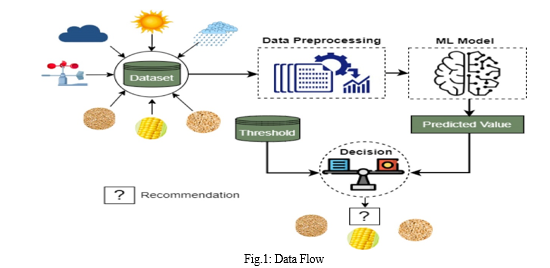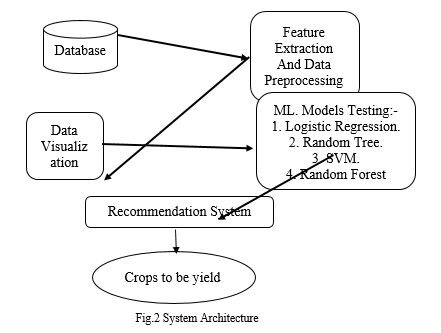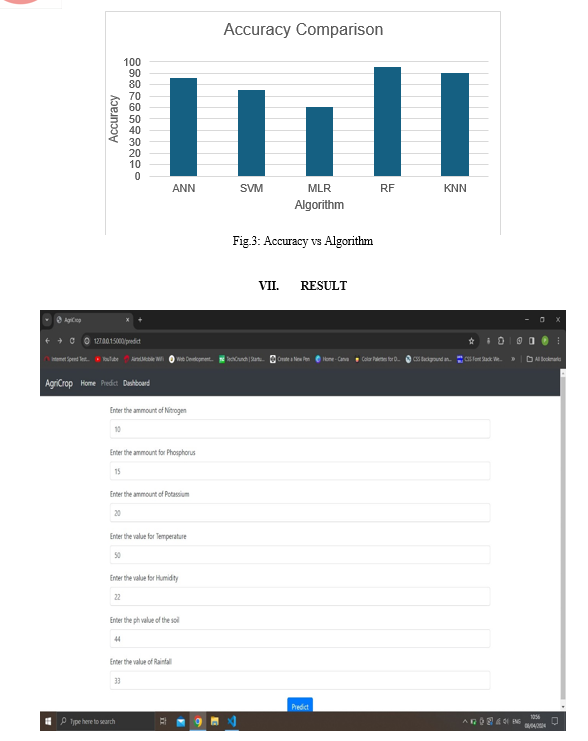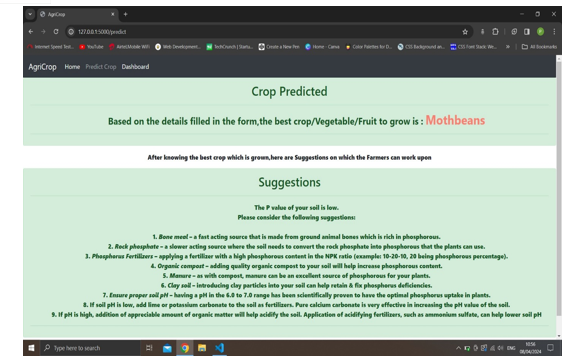Ijraset Journal For Research in Applied Science and Engineering Technology
- Home / Ijraset
- On This Page
- Abstract
- Introduction
- Conclusion
- References
- Copyright
Crop Recommendation System
Authors: Gandhale Pradnya, Gawali Sayali, Tikole Snehal, Jangale Neha, Prof Sayyed J. I.
DOI Link: https://doi.org/10.22214/ijraset.2024.62364
Certificate: View Certificate
Abstract
In the wake of climate change and evolving agricultural practices, there is an increasing demand for innovative technologies to enhance crop productivity while ensuring sustainability. This abstract presents a comprehensive overview of a state-of-the-art Crop Recommendation System (CRS) designed to assist farmers in making informed decisions regarding crop selection. The CRS utilizes machine learning algorithms and data analytics techniques to analyze various factors such as soil type, climate conditions, historical crop performance, market trends, and farmer preferences. Through the integration of satellite imagery, weather data, soil composition analysis, and historical crop yields, the CRS generates personalized recommendations tailored to specific agricultural contexts.
Introduction
I. INTRODUCTION
Agriculture, being the cornerstone of human civilization, has witnessed significant transformations over millennia, driven by technological advancements, changing environmental conditions, and evolving consumer demands. In recent years, the integration of data science and machine learning techniques into agricultural practices has led to the emergence of Crop Recommendation Systems (CRS), which aim to revolutionize crop management and decision-making processes for farmers worldwide. Traditional agricultural practices often rely on heuristics, anecdotal knowledge, and historical precedents for crop selection, leading to suboptimal outcomes in terms of yield, resource utilization, and environmental sustainability. Moreover, the increasing unpredictability of weather patterns due to climate change exacerbates the challenges faced by farmers, necessitating more sophisticated and data-driven approaches to crop planning. Crop Recommendation Systems represent a paradigm shift in agricultural decision support, leveraging vast amounts of data from diverse sources such as satellite imagery, soil sensors, weather stations, market trends, and historical crop performance records. By harnessing the power of machine learning algorithms, these systems analyze and interpret complex datasets to generate personalized recommendations tailored to the unique characteristics of each farm or agricultural plot. The primary objective of Crop Recommendation Systems is to assist farmers in making informed decisions regarding crop selection, planting schedules, and agronomic practices, with the overarching goal of maximizing yield, profitability, and sustainability.

II. RELATED WORK
Research in crop recommendation systems using machine learning (ML) has gained traction in recent years due to its potential to enhance agricultural productivity and sustainability. Here's an outline of related work in this field:
- Data-driven Approaches: Many studies leverage large agricultural datasets, including soil characteristics, weather patterns, historical crop yields, and farmer practices, to develop ML models. These models aim to predict the most suitable crops for a given location based on these data inputs.
- Feature Engineering: Researchers often employ feature engineering techniques to extract relevant information from raw agricultural data. This may involve transforming variables, handling missing values, or creating new features to improve model performance.
- Model Selection and Evaluation: Various ML algorithms are utilized, including decision trees, random forests, support vector machines, and neural networks. Researchers typically compare the performance of these models using metrics such as accuracy, precision, recall, and F1-score. Cross-validation and grid search techniques are commonly used for hyper parameter tuning and model selection.
- Integration of Remote Sensing Data: Some studies incorporate remote sensing data, such as satellite imagery and aerial photography, to provide additional insights into crop health, vegetation indices, and land use patterns. These data sources can enhance the accuracy of crop recommendation models by capturing real-time environmental factors.
- User Interaction and Feedback: Certain systems allow for user interaction and feedback, enabling farmers to provide input on their preferences, constraints, and local knowledge. This user-centric approach enhances the relevance and usability of the recommendations provided by the system.
- Spatial and Temporal Considerations: Effective crop recommendation systems must account for spatial variability in soil properties, climate conditions, and crop suitability across different regions. Moreover, temporal dynamics, such as seasonal changes and crop rotation practices, need to be considered for accurate recommendations over time.
- Transfer Learning and Ensemble Methods: To address data scarcity or domain adaptation challenges in certain regions, transfer learning techniques and ensemble methods may be employed. These approaches leverage knowledge from related domains or ensemble multiple models to improve generalization performance.
- Scalability and Deployment: Scalability and ease of deployment are crucial considerations for practical implementation. Cloud-based architectures, distributed computing frameworks, and lightweight ML models are explored to facilitate real-time recommendations and accommodate diverse computing environments.
By examining these aspects of related work, researchers can identify opportunities for innovation and improvement in crop recommendation systems using ML techniques.
III. KNOWLEDGE DISCOVERY IN DATABASE
Knowledge Discovery in Databases (KDD) represents a systematic process of extracting useful knowledge from large volumes of data. In the context of agriculture, KDD techniques enable the exploration and analysis of diverse datasets encompassing soil characteristics, climate conditions, historical crop yields, pest and disease incidence, market trends, and agronomic practices. By uncovering hidden relationships and trends within these datasets, KDD empowers CRS to generate personalized and actionable recommendations tailored to specific agricultural contexts.
Key Components of Knowledge Discovery in Databases for Crop Recommendation Systems:
- Data Preprocessing: The first step in the KDD process involves data preprocessing, which includes tasks such as data cleaning, integration, transformation, and reduction. Agricultural datasets are often heterogeneous and noisy, containing missing values, outliers, and inconsistencies. Data preprocessing techniques help to address these challenges, ensuring that the data is suitable for analysis by CRS.
- Feature Selection: Feature selection techniques are employed to identify the most relevant variables or features from the dataset that have a significant impact on crop productivity and performance. By reducing the dimensionality of the data and focusing on key predictors, feature selection enhances the efficiency and accuracy of crop recommendations generated by CRS.
- Pattern Discovery: Pattern discovery algorithms, such as association rule mining, clustering, and classification, are utilized to uncover meaningful patterns and relationships within agricultural datasets. These patterns may include correlations between soil attributes and crop yields, spatial clusters of pest infestations, or temporal trends in weather patterns. By identifying such patterns, CRS can generate insights that inform crop selection, planting schedules, and agronomic interventions.
- Predictive Modeling: Predictive modeling techniques, including regression, decision trees, neural networks, and ensemble methods, are employed to build predictive models that forecast crop yields, pest outbreaks, and market prices based on historical data and current environmental conditions. These models serve as the backbone of CRS, enabling the generation of accurate and timely recommendations for farmers.
A. Benefits and Challenges
The integration of knowledge discovery techniques into Crop Recommendation Systems offers several benefits, including:
- Enhanced Decision-Making: By uncovering hidden patterns and relationships within agricultural datasets, KDD empowers farmers to make more informed decisions regarding crop selection, planting strategies, and resource allocation.
- Improved Crop Productivity: By leveraging predictive modeling techniques, CRS can forecast crop yields and identify optimal planting windows, leading to improved productivity and profitability for farmers.
- Adaptive and Resilient Farming: KDD enables CRS to adapt dynamically to changing environmental conditions and incorporate feedback from ongoing monitoring, thereby enhancing the resilience of farming systems to climate variability and other external factors.
However, the integration of knowledge discovery techniques into CRS also poses certain challenges, including:
a. Data Quality and Availability: Agricultural datasets may suffer from issues related to data quality, such as missing values, inaccuracies, and inconsistencies. Moreover, access to relevant and up-to-date data may be limited in certain regions or agricultural sectors.
b. Interpretability and Transparency: While predictive models generated through KDD techniques can yield accurate predictions, their interpretability and transparency may be limited, making it challenging for farmers to understand the rationale behind the recommendations generated by CRS.
c. Scalability and Computational Complexity
IV. METHODOLOGY
Despite recent proposals of many solutions, open challenges persist in creating a user-friendly crop recommendation system using machine learning. Application with respect to crop recommendation.
The solution proposed here aims to solve these limitations, by developing a user-friendly application that considers the parameters like rainfall, temperature, soil type etc. that directly affect Efforts are made to improve crop varieties through cultivation crops that can be grown over the season. The proposed system
Minimizing the difficulties faced by farmers in choosing a crop and maximizing yield can effectively reduce the challenges associated with crop selection. Suicide rates.
The proposed model predicts crop yield for datasets in the given region. Integrating agriculture and ML will contribute to enhancing the agriculture sector by increasing yields and optimizing involved resources. Historical data from previous years serves as key elements in forecasting current performance.
Various reliable sources such as data.gov.in, kaggle.com, and indianwaterportal.com provide the historical datasets for Maharashtra and Karnataka regions.
These datasets include attributes like state, district, year, season, crop type, cultivated area, and production. Soil type, extracted from separate datasets with state and district specifications, is merged into the main dataset. Similarly, temperature and average rainfall data from separate sources are incorporated into the main datasets for the specific region. The datasets undergo cleaning and preprocessing, with null values replaced by mean values. Categorical attributes are converted into labels before algorithm processing, utilizing the one-hot encoding method to manage categorical values.
Figure 2 depicts the system architecture of the proposed model, which is a mobile app comprising two modules: the prediction module and the fertilizer module.
The mobile application offers multiple services. Farmers initiate the process by registering with the app. Upon completion of registration, farmers gain access to the mobile application services. The prediction module utilizes selected attributes from the datasets to forecast crop yield for specific crops.
Additionally, it recommends crops with the highest yield to the farmer. The fertilizer module provides guidance to farmers on the optimal timing for fertilizer application

V. SOFTWARE AND HARDWARE REQUIREMENT
A. Software Requirements
- Languages: Python,
- Libraries: scikit-learn, TensorFlow/Keras, PyTorch, Pandas, NumPy
- Visualization: Matplotlib, Seaborn, Plotly
- Development: VS Code
B. Hardware Requirements
- Sensors: Soil moisture, temperature, humidity
- IoT Gateways: For data collection and transmission
- Communication Modules: Wi-Fi
VI. ALGORITHMS
Here are some common algorithms used in crop recommendation systems employing machine learning, along with brief descriptions of their roles:
- Decision Trees: These algorithms create a tree-like model of decisions based on features such as soil type, weather conditions, and crop history to recommend the most suitable crops.
- Random Forests: An ensemble method that combines multiple decision trees to improve accuracy and handle overfitting, offering robust crop recommendations.
- Support Vector Machines (SVM): SVMs find the optimal hyperplane that separates different crop suitability classes, making precise recommendations based on input features.
- K-Nearest Neighbors (KNN): This algorithm recommends crops by finding the most similar historical instances (neighbors) in the dataset and predicting the best crop based on majority voting.
- Multiple Linear Regression (MLR): Algorithm can be effectively used in crop recommendation systems to predict crop yields and suitability based on various input features.
- Artificial Neural Networks (ANNs): Deep learning models that can capture complex patterns and interactions between features to provide highly accurate crop recommendations.


VIII. FUTURE SCOPE
Project could be used further improved by increasing the volume of observation i.e., soil test data. models like AI could be used to get more accurate results. The future scope of crop recommendation systems using machine learning is vast and promising, driven by advancements in technology, increasing agricultural challenges, and the need for sustainable farming practices. Here are several key areas where crop recommendation systems are likely to evolve and have a significant impact:
A. Precision Agriculture
Data Integration: Integrating data from various sources such as soil sensors, weather stations, and satellite imagery to provide more accurate and localized recommendations.
Real-Time Recommendations: Leveraging IoT devices for real-time monitoring and instant recommendations to farmers, improving crop management and yield.
B. Sustainable Farming Practices
Resource Optimization: Using machine learning to optimize the use of water, fertilizers, and pesticides, reducing environmental impact and promoting sustainability.
Climate Resilience: Developing models that can predict the best crops to grow under changing climate conditions, helping farmers adapt to climate change.
C. Personalized Farming Solutions
Customized Recommendations: Creating highly personalized crop recommendations based on the specific conditions of individual farms, such as soil health, local climate, and historical crop performance.
Smallholder Farmer Support: Designing solutions tailored for smallholder farmers in developing regions, who have limited access to traditional agricultural advisories.
D. Enhanced Decision Support Systems
Advanced Analytics: Employing advanced analytics and AI to predict market trends, price fluctuations, and demand, helping farmers make informed decisions about which crops to plant.
Risk Management: Providing risk assessments for different crop choices, helping farmers mitigate potential losses due to adverse weather, pests, or market conditions.
E. Integration with Other Technologies
Blockchain for Transparency: Integrating blockchain technology to ensure transparency and traceability in the agricultural supply chain, from farm to fork.
Robotics and Automation: Using autonomous machinery guided by machine learning to execute precision farming practices recommended by the system.
F. Scaling and Accessibility
Scalable Solutions: Developing scalable machine learning models that can be easily adapted to different regions and types of farming.
Conclusion
This paper first outlines the limitations of current systems and their practical usage in yield prediction. It then introduces a viable yield prediction system tailored for farmers, which provides connectivity through a mobile application. The mobile application incorporates multiple features that users can leverage for crop selection. The built-in predictor system assists farmers in predicting the yield of a chosen crop. Additionally, the built-in recommender system enables users to explore potential crops and their expected yields, facilitating more informed decision-making. For accuracy in yield prediction, various machine learning algorithms such as Random Forest, ANN, SVM, MLR, and KNN were implemented and tested on datasets from Maharashtra and Karnataka states. The performance of these algorithms was compared based on their accuracy. The results indicate that Random Forest Regression outperforms other standard algorithms, achieving an accuracy of 95% on the given datasets. Furthermore, the proposed model explores the timing of fertilizer application and provides recommendations for the appropriate duration. Future work will focus on updating datasets periodically to ensure accurate predictions, with a potential for automating these processes. Additionally, there are plans to implement functionality that provides recommendations on the correct type of fertilizer for optimal crop growth. To conduct a thorough study of available fertilizers and their relationship with soil and climate for a given crop and location, it is necessary to implement this analysis. This includes conducting an analysis of available statistical data.
References
[1] Singh, A. K., Kumar, V., & Sinha, N. (2019). A Survey of Crop Recommendation Systems: Approaches and Applications. In International Conference on Computational Intelligence and Data Science (pp. 1-13). Springer, Singapore. [DOI: 10.1007/978-981-13-2960-9_1] [2] Omamoke, N. A., & Oluwagbemi, S. A. (2020). Crop Recommendation System for Precision Agriculture Using Machine Learning Techniques. IEEE. [DOI: 10.1109/AISP47742.2020.9297884] [3] Abhiram, P. S., et al. (2019). Crop Recommendation System Based on Soil and Weather Conditions Using Decision Tree Algorithm. IEEE. [DOI: 10.1109/ICACCCT.2019.8884889] [4] Yadav, R., et al. (2020). Crop Recommendation System Using Machine Learning Algorithms and IoT Technology. IEEE. [DOI: 10.1109/ICESC49402.2020.9068352] [5] Ghule, S. B., & Dudul, S. V. (2018). A Framework for Crop Recommendation System Based on Fuzzy Logic and Expert System. . IEEE. [DOI: 10.1109/GUCON.2018.8657452] [6] Patil, S. M., & Jondhale, S. S. (2017). Crop Recommendation System Using Data Mining Techniques.IEEE. [DOI: 10.1109/ICCUBEA.2017.8259937] [7] Garg, K., & Padole, S. S. (2017). \"Crop recommendation system using data mining techniques: A review.\" In 2017 International Conference on Big Data Analytics and Computational Intelligence (ICBDAC) (pp. 261-264). IEEE. [8] Garg, A., & Kumar, M. (2019). \"In the 2019 International Conference on Intelligent Sustainable Systems (ICISS), a crop recommendation system was presented, employing a machine learning approach. (pp. 601-605). IEEE. [9] Nagpal, A., & Singh, R. (2018). \"At the 2018 International Conference on Information and Communication Technology for Intelligent Systems (ICTIS), an agricultural crop recommendation system was introduced, utilizing machine learning techniques. (ICTIS) (pp. 330-336). IEEE. [10] Agrawal, A., & Patidar, A. (2019). \"Crop recommendation system based on machine learning techniques.\" In 2019 IEEE 9th International Conference on Advanced Computing (IACC) (pp. 539-544). IEEE. [11] Gowthami, B. S., & Priyadharshini, R. (2020). \"Crop Recommendation System using Machine Learning Algorithms.\" In 2020 International Conference on Communication and Signal Processing (ICCSP) (pp. 1456-1460). IEEE. [12] Kour, H., et al. (2021). \"Machine Learning Based Crop Recommendation System.\" This paper discusses the development of a crop recommendation system using various machine learning algorithms and evaluates their performance based on different metrics. [13] Patel, J., et al. (2015). \"A machine learning technique maximizes crop yield using a crop recommendation system.\"The study focuses on using machine learning techniques to maximize crop yield by providing farmers with crop recommendations based on soil and weather conditions. [14] Ramteke, R. J., & Padole, P. (2017). \"Machine learning algorithms create an efficient crop recommendation system.\"This paper explores different machine learning algorithms to recommend suitable crops for specific conditions, aiming at increasing agricultural productivity. [15] Aggarwal, C. C. (2018). \"Foundations and techniques support machine learning for data science.\"This book provides a solid foundation in machine learning techniques, which are essential for developing crop recommendation systems.
Copyright
Copyright © 2024 Gandhale Pradnya, Gawali Sayali, Tikole Snehal, Jangale Neha, Prof Sayyed J. I.. This is an open access article distributed under the Creative Commons Attribution License, which permits unrestricted use, distribution, and reproduction in any medium, provided the original work is properly cited.

Download Paper
Paper Id : IJRASET62364
Publish Date : 2024-05-19
ISSN : 2321-9653
Publisher Name : IJRASET
DOI Link : Click Here
 Submit Paper Online
Submit Paper Online

